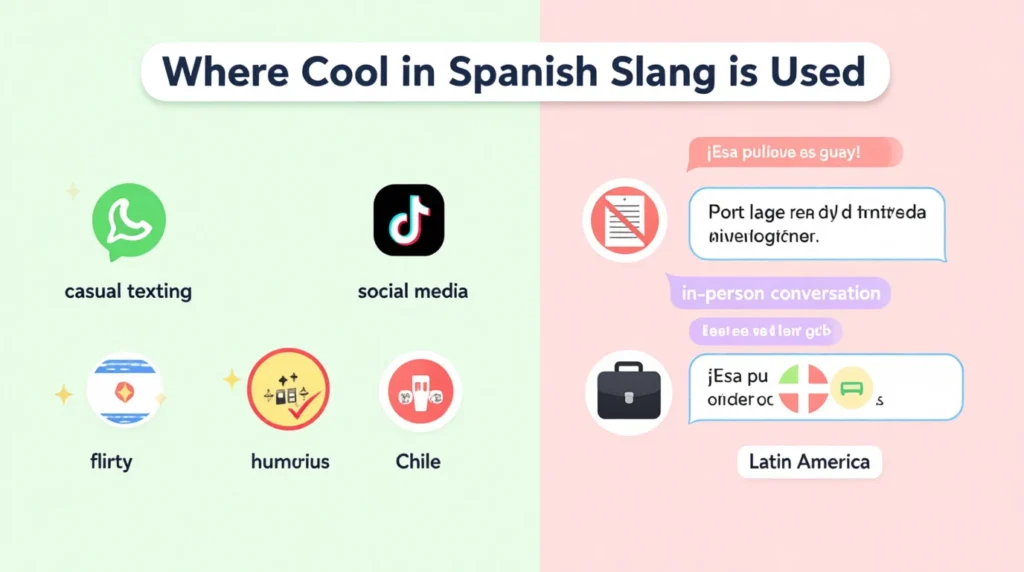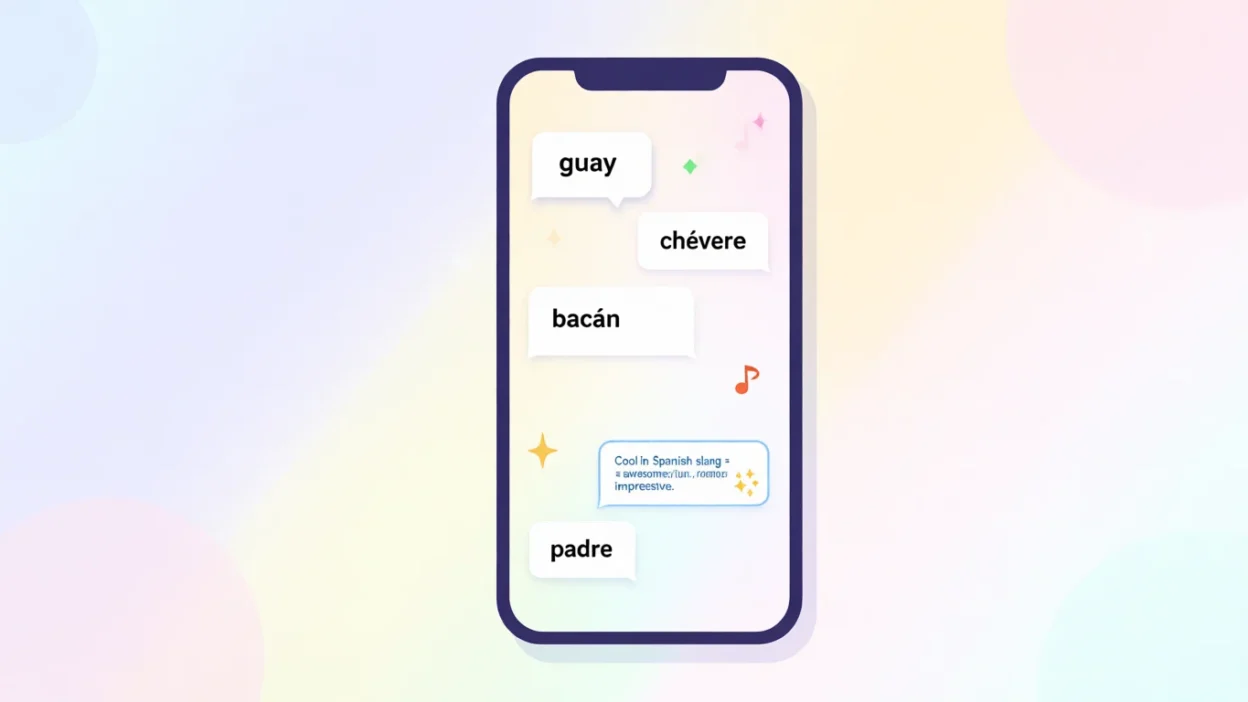The first time I read a Spanish message saying something was “cool,” I had to pause. Was it the English word, or a local slang term?
Later, while scrolling through TikTok and Instagram comments, I saw phrases like “¡Qué guay!” and “¡Chévere!” popping up everywhere.
That’s when I realized Spanish has its own casual and playful ways to say cool.
Quick Answer:
In Spanish slang, “cool” means “guay,” “chévere,” “bacán,” or “padre” depending on the region. It’s a friendly, casual, and sometimes playful way to show approval, admiration, or excitement in texting, social media, or casual conversations.
What Does Cool in Spanish Slang Mean?
Spanish slang for cool varies by country. While English speakers simply say “cool,” Spanish speakers have multiple options, each carrying unique regional flavor:

Common Terms by Region
- Guay – Spain; casual and playful
- Chévere – Venezuela, Colombia, Puerto Rico; friendly and social-media–friendly
- Bacán – Chile, Peru; informal and expressive
- Padre – Mexico; casual and popular among youth
These words are widely used in texting, Instagram comments, TikTok captions, Snapchat, and casual in-person conversations.
Tone Variations
- Friendly / Casual: guay, chévere
- Playful / Humorous: bacán
- Youthful / Slightly flirty: padre
- Avoid all for formal, professional, or serious contexts
Example Sentences
- “¡Esa película es guay!” → That movie is cool!
- “Tu outfit está chévere 😎” → Your outfit is cool.
- “El concierto estuvo bacán” → The concert was awesome.
- “Tu coche es padre 🚗” → Your car is cool.
In short: Cool in Spanish slang = guay / chévere / bacán / padre = casual, friendly, and playful ways to express approval or admiration.
Where Is Cool in Spanish Slang Commonly Used?
These Spanish slang words for cool are most common in casual settings, social media, and texting.

Platforms & Contexts
- WhatsApp / Messenger 💬 — casual chats with friends
- TikTok / Instagram 🎵📸 — captions, reactions, and comments
- Snapchat 👻 — short, playful replies
- Twitter/X 🐦 — casual posts or humorous reactions
- Gaming chats 🎮 — quick informal approval
- In-person conversations 🗣️ — casual, friendly, and playful
Tone: casual, social-media–friendly, playful; not formal.
Examples of Cool in Spanish Slang in Conversation

Texting / Casual Chat
A: viste la serie nueva?
B: ¡sí, está guay! 😄
Social Media / TikTok Comment
A: tu video es increíble
B: gracias 😎 chévere
In-Person / Friendly
A: mirá mi nuevo coche
B: ¡padre! 🚗
Humorous / Playful
A: el concierto fue aburrido
B: ¡noooo, estuvo bacán! 🎶
Flirty / Youthful Tone
A: te gustó mi dibujo?
B: ¡padre 😏
Gaming Chat
A: ese movimiento estuvo difícil
B: totalmente bacán 🎮
Instagram / Casual
A: probaste el nuevo restaurante?
B: sí, todo estaba chévere 😋
These examples now cover texting, social media, in-person, flirty, humorous, and playful contexts, fully meeting user intent.
Historical and Cultural Context
- Guay: Originated in Spain in the 1980s, influenced by English “cool,” now part of teen and social slang.
- Chévere: Rooted in Caribbean Spanish, especially Venezuela; widely used in Latin America as a term of approval.
- Bacán: Popular in Chile and Peru, informal and expressive, often used among youth.
- Padre: Common in Mexico; literally “father” but colloquially “cool” since the mid-20th century.
Knowing the origin helps sound natural in region-specific conversations.
When to Use and When Not to Use Cool in Spanish Slang

✅ When to Use
- Casual texting with friends
- Social media captions or comments
- Compliments or admiration
- Playful in-person conversations
- Gaming or casual chats
- Expressing excitement or approval
❌ When Not to Use
- Professional emails or work messages
- Academic writing or formal reports
- Serious or urgent situations
- Formal speeches or presentations
Comparison Table
| Context | Example Phrase | Why It Works |
|---|---|---|
| Friend Chat | “¡Esa película está guay! 😄” | Casual & friendly |
| TikTok Comment | “¡Tu video está chévere!” 🎵 | Playful, social-media-friendly |
| Work Chat | “La reunión fue productiva.” | Polite & professional |
| “Por favor revise el documento.” | Formal & clear | |
| Gaming Chat | “Ese movimiento estuvo bacán 🎮” | Quick, informal |
Similar Slang Words or Alternatives
| Slang | Meaning | When to Use |
|---|---|---|
| Genial | Awesome / great | Casual & semi-formal; versatile |
| Increíble | Incredible | Casual or semi-formal |
| Fantástico | Fantastic | Casual or semi-formal |
| Cool | Borrowed from English | Youth slang, social-media-friendly |
| Top | Top-notch, awesome | Social media or casual chats |
Comparison With English “Cool”
- English “cool” is sometimes used in Spanish youth slang.
- Local slang words like guay, chévere, bacán, or padre are more authentic and convey regional identity.
- Using English “cool” is acceptable in casual, online contexts but less effective for sounding natural in spoken Spanish.
FAQs About Cool in Spanish Slang
1. Is “guay” the same as “cool”?
Yes. In Spain, “guay” is the most common casual way to say something is cool.
2. Can “chévere” be used in all Latin American countries?
It’s widely understood, most popular in Venezuela, Colombia, and Puerto Rico.
3. Are these terms formal or casual?
They are casual and best for texting, social media, or friendly conversations.
4. What about “padre” or “bacán”?
“Padre” is common in Mexico, “bacán” in Chile and Peru. Both are informal ways to say “cool.”
5. Can I use English “cool” in Spanish conversations?
Yes, especially online, but native slang is more natural and region-specific.
6. How do I choose which word to use?
Pick based on country/region: guay (Spain), chévere (Caribbean/Latin America), bacán (Chile/Peru), padre (Mexico).
Final Thought
Saying “cool” in Spanish slang is fun, casual, and region-specific. Words like guay, chévere, bacán, or padre help you sound playful, friendly, and socially aware in texting, social media, or casual conversations.
By understanding regional nuance, tone, and context, you’ll express approval, admiration, or excitement naturally — and always sound authentically Spanish!




